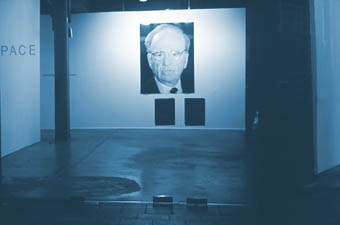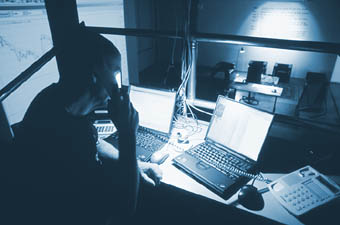Day trading aesthetics: playing with Murdoch
Ned Rossiter

catchafallingknife.com
photo Michael Goldberg
catchafallingknife.com
We are yet to see what capital can become. So goes the ‘new economy’ mantra as its proponents lay claim to the future, which is synonymous with the ‘free market.’ Mastery of the latter supposedly determines the former. Bubble economies—exemplified most spectacularly with dotcom mania and the tech wreck in April 2000, which saw the crash of the NASDAQ—are perhaps one index of the future-present where the accumulation of profit precedes by capturing what is otherwise a continuous flow of information. Information flows are shaped by myriad forces that in themselves are immaterial and invisible, as they do not register in the flow of information itself. The condition of motion nevertheless indelibly inscribes information with a speculative potential, enabling it to be momentarily captured in the form of trading indices.
Michael Goldberg’s recent installation at Sydney’s Artspace—catchafallingknife.com—combines software interfaces peculiar to the information exchanges of day traders gathered around electronic cash flows afforded by the buying and selling of shares in Murdoch’s News Corporation. With $50,000 backing from an anonymous consortium of stock market speculators cobbled together from an online discussion list of day traders, Goldberg bought and sold News Corp shares during 3 weeks in October-November last year (for background to the installation see RT51).
Information flows are at once inside and outside the logic of commodification. The software design of market charts constitutes an interface between informational nodes and flows. The interface captures and contains—and indeed makes intelligible—what are otherwise quite out of control finance flows. But not totally out of control: finance flows, when understood as a self-organised system, occupy a tense space between absolute stability and total randomness. Too much emphasis upon either condition leaves the actor-network system open to collapse. Evolution or multiplication of the system depends on a constant movement or feedback loops between actors and networks, nodes and flows.

catchafallingknife.com
photo Michael Goldberg
catchafallingknife.com
Referring to the early work of political installation artist Hans Haacke, Goldberg explains this process in terms of a “real time system”: “the artwork comprises a number of components and active agents combining to form a volatile yet stable system. Well, that may also serve as a concise description of the stock market…Whether or not the company’s books are in the black or in the red is of no concern—the trader plays a stock as it works its way up to its highs and plays it as the lows are plumbed as well. All that’s important is liquidity and movement. ‘Chance’ and ‘probability’ become the real adversaries and allies.” (Interview with Geert Lovink, www.catchafallingknife.com)
Trading or charting software can be understood as stabilising technical actors that gather information flows, codifying these in the form of “moving average histograms, stochastics, and momentum and volatility markers” (Goldberg). Such market indicators are then rearticulated or translated in the form of online chatrooms, financial news media and mobile phone links to stockbrokers, eventually culminating in the trade. In capturing and modelling finance flows, trading software expresses various regimes of quantification that enable a value-adding process through the exchange of information within the immediacy of an interactive real time system. Such a process is distinct from “ideal time,” in which “the aesthetic contemplation of beauty occurs in theoretical isolation from the temporal contingencies of value” (Ed Shanken, “Art in the Information Age”, www.duke.edu/~giftwrap/ InfoAge.html).
An affective dimension of aesthetics is registered in the excitement and rush of the trade; biochemical sensations in the body modulate the flow of information, and are expressed in the form of a trade. As Goldberg puts it in a report to the consortium halfway through the project after a series of poor trades based on a combination of ‘technical’ and ‘fundamental’ analysis: “It’s becoming clearer to me that in trading this stock one often has to defy logic and instead give in, coining a well-worn phrase, to irrational exuberance.” Here, the indeterminacy of affect subsists within the realm of the processual, where a continuum of relations defines the event of the trade. Yet paradoxically, such an affective dimension is coupled with an intensity of presence where each moment counts; the art of day trading is an economy of precision within a partially enclosed universe.
However, the borders of a processual system are also open to the needs and interests of external institutional realities. The node of the gallery presents what is otherwise a routine operation of a day trader as a minor event, one that registers the growing similarities between art and commerce. Interestingly, the event-space of the gallery expresses the regularity of day trading with a difference that submits to the spatio-temporal dependency news media has on the categories of ‘news worthiness.’
A finance reporter for Murdoch’s The Australian newspaper reports on Goldberg’s installation. Despite the press package, which details otherwise, the journalist attempts to associate Goldberg’s trading capital with an Australia Council grant (which financed the installation costs) as further evidence of the moral and political corruption among the ‘chattering classes.’ In this instance of populist rhetoric, the distinction between quality and tabloid newspapers is brought into question. The self-referentiality that defines organisation and production within the mediasphere prompts a journalist from Murdoch’s local Sydney tabloid, the Daily Telegraph, to submit copy on the event. Unlike the dismissive account in The Australian and the general absence of attention to the project by arts commentators, Goldberg notes how the Daily Telegraph report made front page of the Business section (rather than the News or Entertainment pages), in full colour, with his picture beside the banner headline “Profit rise lifts News.” The headline for Goldberg’s installation was smaller: “Murdoch media the latest canvas for artist trader.”
Here, the system of relations between art and commerce also indicates the importance that storytelling has in an age of information economies. Whether the price of stocks goes up or down, profit value is not shaped by the kind of political critique art might offer, but rather by the kind of spin a particular stock can generate. Goldberg’s installation discloses various operations peculiar to the aesthetics of day trading, clearly establishing a link between narrative, economy, time and risk, performance or routine practice and the mediating role of design and software aesthetics. catchafallingknife.com demonstrates that it is the latter—a theory of software—that still requires much critical attention. And unlike most players in the new economy, Goldberg’s installation was a model of accountability and transparency.
catchafallingknife.com, Michael Goldberg, Artspace, Sydney, Oct 17-Nov 19, 2002. www.catchafallingknife.com
RealTime issue #53 Feb-March 2003 pg. 25






